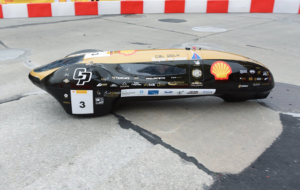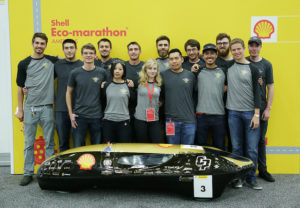Many student teams in high school and college divisions compete to build, and race, a vehicle that uses the least amount of gas to complete a certain distance, and several have used 3D printing in the past to design their fuel-efficient race cars. Teams start with a single cylinder lawnmower engine, and develop design modifications to meet the goal of constructing a single-person vehicle with optimal fuel consumption.
 Global 3D printing leader Stratasys has used its technology to ramp up race car performance before, and recently gave a helping hand to the Shell Eco-marathon team from California Polytechnic State University (Cal Poly) as they prepare for the 2018 competition. A recent piece from Carrie Wyman relays the collaborative project in a Stratasys blog post.
Global 3D printing leader Stratasys has used its technology to ramp up race car performance before, and recently gave a helping hand to the Shell Eco-marathon team from California Polytechnic State University (Cal Poly) as they prepare for the 2018 competition. A recent piece from Carrie Wyman relays the collaborative project in a Stratasys blog post.
The team’s award-winning, multidisciplinary Supermileage club, made up of design and engineering students, placed fourth out of over 40 teams in the 2017 Eco-marathon competition. The vehicle they developed, the Ventus II RS, was able to achieve 1,500 miles per gallon, and the students didn’t want to lose any momentum this year. Their goal: beat Cal Poly’s all-time school record of 2,752 miles per gallon.
The Cal Poly Supermileage team’s major focus, as they enter the design and iteration mode for next month’s Shell Eco-marathon Americas in Sonoma, is to transfer end-to-end designs from previous generations of competition and performance testing to the current club and its new race car, while still keeping the future of fuel-efficient vehicles at the forefront.
Weston Andrew Cramer, a third year member of the Cal Poly Supermileage team, said, “Essentially what we do, is kind of like what Apple does with the iPhone 6 vs. the iPhone 6S, where it’s basically the same chassis of the model, but the interior of it is remodeled to make it faster and more efficient. That’s kind of how Supermileage operates, because making a chassis is extremely expensive, there’s a lot of analysis, and material, like carbon fiber that go into it; and of course a lot of man hours.
“So, last year, we took the chassis and redesigned it to absorb more shock and duress in general. Then, we took a look at the interior and updated the look and some of the safety elements as well. Basically every part inside the car was revamped.”
The team made two major changes to the vehicle’s interior design which majorly impacted both its safety and construction. First, they changed the race car’s braking mechanism from a hand brake to a foot brake. Then, the team members, according to the blog post, “leveraged the strength to weigh benefits of FDM materials” and chose to use Stratasys’ Ultem material to 3D print the steering wheel.
Cal Poly Supermileage alumnus Eli Rogers, who has worked professionally in the 3D printing industry since he graduated, explained that, “With FDM prints being strong in plane, instead of a more detail oriented isotropic material, like the with the polyjet.”
It’s important with any race car for the steering wheel to perfectly fit the driver’s hands to reduce stress and pain, which is why several other race cars have also 3D printed this important part. In addition, 3D printing can help make components like these more lightweight, and at less cost.
Rogers says that his collegiate Supermileage racing experience was “rewarding,” and that he can see and feel the impacts from being on the team in his daily 3D printing design work.
“At the club level, we do so much work that you don’t get to experience in the classroom, work that prepares you for a job that has stresses like a situation where the customer doesn’t know the answer, and you are tasked, as the engineer on the job, to find the answer with the best possible outcome for the customer,” Rogers said.
3DPrint.com would like to wish the Cal Poly Supermileage team the best of luck at next month’s Shell Eco-marathon Americas Competition.
https://www.facebook.com/supermileage/videos/1619495238106318/
Discuss this and other 3D printing topics at 3DPrintBoard.com or share your thoughts below.
[Source: Stratasys / Images: Cal Poly Supermileage Facebook Page]
Subscribe to Our Email Newsletter
Stay up-to-date on all the latest news from the 3D printing industry and receive information and offers from third party vendors.
Print Services
Upload your 3D Models and get them printed quickly and efficiently.
You May Also Like
Reinventing Reindustrialization: Why NAVWAR Project Manager Spencer Koroly Invented a Made-in-America 3D Printer
It has become virtually impossible to regularly follow additive manufacturing (AM) industry news and not stumble across the term “defense industrial base” (DIB), a concept encompassing all the many diverse...
Inside The Barnes Global Advisors’ Vision for a Stronger AM Ecosystem
As additive manufacturing (AM) continues to revolutionize the industrial landscape, Pittsburgh-based consultancy The Barnes Global Advisors (TBGA) is helping shape what that future looks like. As the largest independent AM...
Ruggedized: How USMC Innovation Officer Matt Pine Navigates 3D Printing in the Military
Disclaimer: Matt Pine’s views are not the views of the Department of Defense nor the U.S. Marine Corps Throughout this decade thus far, the military’s adoption of additive manufacturing (AM)...
U.S. Congress Calls Out 3D Printing in Proposal for Commercial Reserve Manufacturing Network
Last week, the U.S. House of Representatives’ Appropriations Committee moved the FY 2026 defense bill forward to the House floor. Included in the legislation is a $131 million proposal for...






































